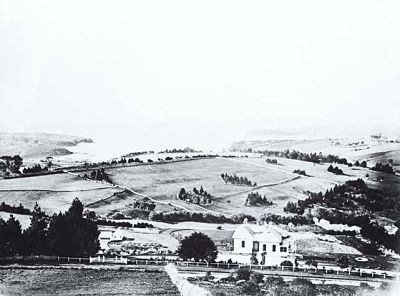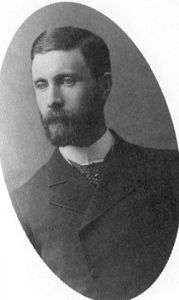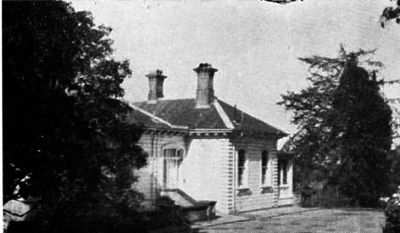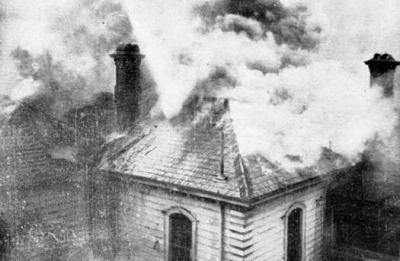Dunholme
Dunholme was built in the 1870s by Auckland businessman Samuel Morrin on the corner of Remuera Road and what is now Ridings Road.
About that time Samuel and his brother Thomas had bought around 30,000 acres to establish an estate called Lockerbie with a nearby town called Morrinsville to house their workers. The Morrin brothers never stayed nor settled in Morrinsville. [1]
After 12 years Dunholme was sold to Thomas Buddle of the Auckland legal firm Buddle Richmond and Buddle. Thomas Buddle’s father was the Reverend Thomas Buddle, one of the founders of the Methodist Church in New Zealand and founding principal of Three Kings Theological and Training Institution (later Wesley College). [2]
In 1909 Dunholme was described as “10 acres, with large frontage to Remuera road, the property of Mr. Thos. Buddle, known as “Dunholme,” will be sold by auction. The residence, which is a two-storied one, built upon concrete foundations, is replete with every modern convenience. Extensive outbuildings, including gardener’s cottage of 6 rooms, large stable and coach house, cowsheds, vineries, greenhouses, etc. The grounds are tastefully laid out. The property is also admirably suited for subdivision.” [3]
Dunholme was bought by Andrew Caughey in 1912. Andrew Clarke Caughey, draper co-founder with his sister Marianne of Smith and Caughey, was also an active Methodist. He had emigrated to New Zealand from Portaferry, County Down, Northern Ireland in 1880 and was a student at Wesley College, Three Kings, serving a portion of the probationary period for the Methodist ministry. He then leased Dunholme to the Methodist Church at a peppercorn rental as a Methodist Theological College. When it became the College, in order to accommodate ten students, two extra rooms were built, a few feet away from the main building, and still later two more rooms and conveniences were added, thus making comfortable accommodation for fourteen students. When the number of students increased to twenty, a cottage in the grounds was renovated for the additional men. [4]
The first meeting of the Management Committee of “Dunholme” was held in Mr. V. L. Prime’s office on Wednesday, June 5th, 1912. Those present were the Rev. W. Ready (President of the Conference), the Revs. C. E. Beecroft, G. Bond, T. G. Carr, C. H. Garland; W. A. Hay, Messrs. G. A. Buttle, A. C. Caughey, T. W. Jones, A. Peak, J. H. Shackleford, J. Veale, J. E. Wheeler, and J. Ambury. The Rev. A. C. I.awry was Convenor. The Rev. C. H. Garland was appointed Principal. The first meeting of this Committee, in “Dunholme,” took place on December 2nd, 1912. On July 21st, 1914, the Committee decided that the institution should be styled Wesley Theological College, and the motto was: “Orbis provincia nostra,” — “The world is our parish.” But at a meeting held on October 17th, 1914, the name of the institution was changed to the Methodist Theological College.
In 1915, the College opened with thirteen students in residence, but during the year four of the men left to serve overseas, and two were called out into circuit work as supplies for sick ministers. In 1916, the Management Committee decided that although few, if any, students would be in residence, it would be inadvisable to close the College. In 1917 only two students were due to enter the College, and actually only one attended, and that for only the first term, after which the institution was closed for the remainder of that year, the Principal with his wife and family remaining in residence, with three paying boarders. Principal Garland died suddenly at the College on November 4th, 1918. The College was re-opened in 1919 with only two students in residence.
When Andrew Caughey leased “Dunholme” to the Church at a very low rental from 1912 to 1928, he gave many generous donations to improve the facilities. The following are typical entries in the Minutes of the Management Committee:
“Mr. Garland reported that Mr. A. C. Caughey was prepared to lay down an asphalt tennis court and suggested that we pay the interest on the money expended.” (July 21st, 1914.)
“Owing to the sale of part of the property at “Dunholme,” it was necessary to erect a new wash-house. Mr. Caughey would donate £50 towards the cost.” (June 18th, 1925.)
“Additional accommodation. The generous offer by Mr. A. C. Caughey of the cottage on the “Dunholme” property was reported. Seven students would be accommodated here. Mr. Caughey had also offered to put the house into first-class condition.” (Dec. 17th, 1925.) [5]
Dunholme housed between 10 and 20 Methodist students but became increasingly inadequate as a training college. The church also wanted to have a college on freehold land. In 1923 the Methodist Church began planning a new college in Grafton on land which was part of a grant made in 1844 by Governor Fitzrov as the site for an institution for the training of Methodist teachers in native work, and there had stood the first school for the purpose, erected in 1845 and presided over by the Rev. Thos. Buddle. The property was part of the Wesley Training College Trust which had facilitated the granting of a long term lease with a purchasing clause. [6]
The occupancy of “Dunholme” as the Methodist Theological College came to an end on December 31st, 1928, and to mark the occasion a special closing function was held. Present were the Rev. W. J. Elliott (President of the Conference), Principal Laws, B.A..D.D., Dr. H. Ranston, M.A., the Rev. H. L. Fiebig, B.A., Messrs. A. C. Caughey and J. Tyler were the principal speakers. Andrew Caughey was reported as being deeply moved. [7]
After the death of Andrew Caughey in December 1928, Dunholme was advertised for sale as “the beautiful and dignified residence situated in Remuera Road, at the foot of Mount Hobson, so well-known to all Aucklanders as Dunholme. This wonderful residence comprises 18 spacious rooms, two bathrooms with dressing room, kitchen, scullery and pantry; upstairs and downstairs balconies. The house stands in beautifully-timbered grounds, and commands a magnificent and unobstructed view of the Coromandel range, Rangitoto, TiriTiri, the Barrier, and the Hauraki Gulf. The situation and view of “Dunholme” is without peer in Auckland, or even in New Zealand.”[8]
The house became a convalescent home for elderly women and later a boarding house. It was destroyed by fire in February 1949. [9] The name Dunholme lives on in a small road off Ridings Road Remuera and in the nearby Dunholme Tennis Club which was started in the 1920s by local resident Richard Pearse, who was the full-time green keeper for the Remuera Bowling Club from 1902 to 1918.
World War I
When the Great War broke out in 1914 “Dunholme” residents’ who served overseas were:
A. A. Bensley, W. T. Blight, O. Burnett, E. B. Chambers A. R. Gordon, M.A., F. T. Harris, H. H. Marshall, S. J. Mogridge , H. J. Odell, E. T. Olds, G. B. Sheridan, W. S. Smith, R. B. Spiers, E. R. Warburton and W. A. Watson.
Roll of Honour
George B. Sheridan was killed in action in the Battle of the Somme on September 15th, 1916. Aldwyn R. Gordon, M.A., died of wounds in France on August 26th, 1918.






